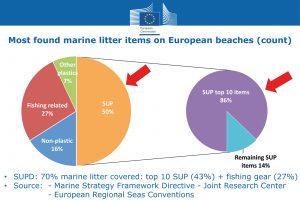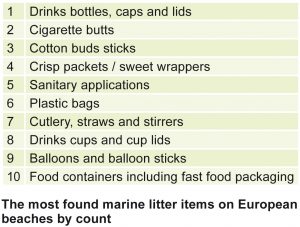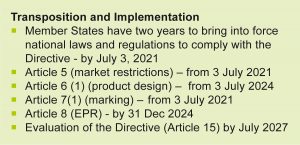4. PETinar: The EU Directive’s impact for the PET value chain
The EU Single Use Plastics Directive EU 2019/904 and its implementation
PETplanet’s fourth PETinar on April 22, 2021 welcomed Dr Rana Pant, Directorate-General for Environment, from the European Commission. In addition to explanations on the general content of the directive, the principal question to arise was: What effects will it have on companies in the PET value chain? A lively Q&A session revealed how much uncertainty there was in the industry – not least because exact guidelines from the EU are still some way off.
The EU aims to become a forerunner in the global fight against marine litter and plastic pollution. Through the EU’s Directive on single-use plastics, different measures are being applied to the most common products found on European beaches as well as fishing gear.
Dr Rana Pant began by explaining the background to the measures in the Directive. “The basic principle on which these measures were based was the question: Are there more sustainable non-plastic or multi-use alternatives available right now on the market?” If so, market restrictions or market bans would be implemented. If there were no clear and more sustainable alternatives, then prevention measures would come into force such as requirements on product design, reducing consumption, improved customer engagement as well as better waste management (separate collection, extended producer responsibility + litter clean-up and in the case of beverage bottles, recycled content).

Article 4 – Consumption reduction
Dr Rana Plant went on to explain Article 4 which deals with a reduction in consumption covering food containers, cups for beverages including covers and lids. “It will be Member States’ responsibility to propose adequate measures to foster a sustained and quantitative reduction in those products. It is important to note while there is a requirement to have a measurable quantitative reduction, there will be no set quantitative target for such reduction. The baseline year is 2022, and the time frame for achieving the quantitative reduction is 2026.” National marketing restrictions are possible for the purposes of preventing those products from becoming litter in order to ensure that they are substituted with alternatives that are re-usable or do not contain plastic.
Article 5 – Market restriction (bans)
Article 5 covers those single-use plastic products for which more sustainable and readily available alternatives have been identified. Products not using such alternatives will be banned as of July 2021.
Article 6 – Product design requirements
The tethering of caps is part of article 6 and stipulates that caps and lids remain attached to beverage containers and bottles up to 3 litres. The auditorium was particularly interested in the publication of a formal standard. In response, Dr Pant stated that work on standardisation is ongoing and acknowledged that this is now “work in progress”. The two organisations responsible for the design standardisation are CEN, the European Committee for Standardisation and CETIE, the international association publishing technical reference documentation on bottling and related subjects. However, Dr Pant pointed out that it is not that the standard itself which is mandatory but the provisions and the Directive. Manufacturers are obliged to observe the terms of the Directive and show compliance to enable them to introduce their product on the market. Compliance with the standard will give presumption of compliance with the Directive. The same article also covers the binding target for Member States to ensure compliance with the recycled content of single-use plastic beverage bottles placed on the market:
- at least 25% of recycled plastic for single-use PET beverage bottles from 2025
- at least 30% of recycled content for all single-use plastic beverage bottles from 2030 (covering all bottles, not only PET bottles)
Article 7 – Marking requirements
This article is related to the marking of products. Products have to be labelled to inform consumers that this product contains plastic and should be disposed of safely. The label should warn the consumer of the negative environmental impact if the product is disposed of inappropriately.
Article 8 – Extended producer responsibility (EPR) (The extended producer responsibility is enshrined in Article 8.)
For food and beverage containers, bottles, cups, packets and wrappers, lightweight carrier bags and tobacco products with filters, producers will help cover the costs of waste prevention (awareness raising); waste management (collection and treatment costs of on-the-go waste in public areas); litter clean-up and data gathering.
Implementation
The commission has to come up with two sets of guidelines, the SUP Guidelines (what is to be considered a single use plastic product, definitions) and guidelines on EPR (criteria on costs of litter clean up). Two standardisation requests are both ongoing concerning tethered caps and lids, according to Art. 6 (plastic bottles); and circularity of fishing gear, Art. 8 (9).
There will be a range of implementation acts regarding:
- Marking, beverage bottles separate collection, reporting of fishing gear and waste collected;
- measuring and reporting consumption reduction by Member States;
- reporting of post consumption waste tobacco products;
- measuring and reporting of recycled content of SUP beverage bottles.
Responsibilities of Member States
EU Member States are obliged to enshrine the stipulations contained in the Directive into national law. Bottle manufacturers may have to adapt to different requirements in different end markets. For example, one member state may decide to only allow bottles that each contain at least 25% rPET in order to achieve the required quota, while another country may opt for a mixed calculation and aim for an average value of at least 25%. However, evidence must be provided and a control and reporting system must be maintained. The EU is to provide rules for the calculation and verification of the targets of rPET that also provides information on how to deal with moisture content, biobased contents etc. Implementation of that verification will be up to Member States. This also includes how to monitor the flow of imported goods for a certain market. Possible sanctions on companies in the event of non-compliance with the State’s own requirements are also subject to the member states.
rPET specifications and availability
Most of the questions that most concerned the 300 or so registered participants in the PETinar related to rPET and in particular to availability, price movements and monitoring. Dr Pant indicated that the 25% recycled content in PET bottles by 2025 should be achievable. According to the Commission’s calculations, it should be even possible to achieve the target of 30% in 2030 with only PET bottles using recycled content (while the target is set for all bottles).
A concern from the auditorium was that, as rPET is more expensive than virgin PET, manufacturers of preforms and bottles could face competition from non-EU countries that do not comply with the Directive. But as compliance is not at the EU level, but wholly on individual Member States, it will be up to Member States themselves to monitor compliance. The recycled content target is not necessarily related to each bottle, each member state must ensure 25% rPET on average in the bottles sold in their market. However, the target is of course applicable to products whether produced within or outside the EU.
By reaching the target above an average value, Member States could help small to medium-sized companies avoid a price war over rPET, which could increase if significant numbers of large companies advertise the fact that they use 100% rPET in their products. Support from the EU will be given in terms of continuing research projects or in the recycling infrastructure to support high quality collection, high quality sorting, high quality recycling and finally a high-quality recycled input back into the value chain processes.
Digging deeper, a participant asked if the directive could ruin Europe’s recycling industry by stimulating an increased import of recycled material from outside the EU. Dr Pant answered: “It is correct that the rPET content in European bottles on the European market does not have to come from Europe. But of course, we look at the whole value chain and with the separate collection, for recycling, of those bottles which are placed on the European market, we hope to improve the situation and availability and as well the price of this recycled material.”
Dr Pant pointed out that the Commission’s intention is not to encourage huge import flows of recycled plastic from outside. On the contrary, there are ambitions to speed up the authorisation process of FCM (food contact material) recycling regulations within the Commission’s Directorate-General for Health and Food Safety (DG Santé) and the European Food Safety Authority EFSA. ”I am confident that by 2025, this will no longer be an issue for PET”.



